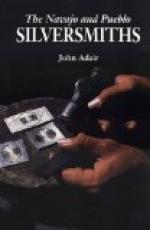Tongs are often made by the Navajo silversmiths. One of these which I saw had a U-shaped spring joint, and the ends were bent at right angles downwards, so as more effectually to grasp the flat-sided crucible. Often nippers or scissors are used as tongs.
Ordinary scissors, purchased from the whites, are used for cutting: their metal after it is wrought into thin plates. The metal saw and metal shears do not seem as yet to have been imported for their benefit. Some of the more poorly provided smiths use their scissors also for tongs, regardless or ignorant of consequences, and when the shears lose their temper and become loose-jointed and blunt, the efforts of the Indian to cut a rather thick plate of silver are curious to see. Often, then, one or two bystanders are called to hold the plate in a horizontal position, and perhaps another will be asked to hold the points of the scissors to keep them from spreading. Scissors are sometimes used as dividers, by being spread to the desired distance and held in position by being grasped in the hand. By this means I have seen them attempt to find centers, but not to describe circles. It is probable that had they trusted to the eye they might have found their centers as well.
Their iron pliers, hammers, and files they purchase from the whites. Pliers, both flat-pointed and round-pointed, are used as with us. Of files they usually employ only small sizes, and the varieties they prefer are the flat, triangular, and rat-tail. Files are used not only for their legitimate purposes, as with us, but the shanks serve for punches and the points for gravers, with which figures are engraved on silver.
The Indians usually make their own cold-chisels. These are not used where the scissors and file can be conveniently and economically employed. The re-entrant rectangles on the bracelet represented in Fig. 4, Pl. XIX, were cut with a cold-chisel and finished with a file.
Awls are used to mark figures on the silver. Often they cut out of paper a pattern, which they lay on the silver, tracing the outline with an awl. These tools are sometimes purchased and sometimes made by the Indians. I have seen one made from a broken knife which had been picked up around the fort. The blade had been ground down to a point.
Metallic hemispheres for beads and buttons are made in a concave matrix by means of a round-pointed bolt which I will call a die. These tools are always made by the Indians. On one bar of iron there may be many matrices of different sizes, only one die fitting the smallest concavity, is required to work the metal in all. In the picture of the smithy (Pl. XVII, in the right lower corner beside the tin-plate), a piece of an old horse-shoe may be seen in which a few matrices have been worked, and, beside it, the die used in connection with the matrices.
[Illustration: Pl. XVIII. Crucible, and sandstone molds for shaping silver objects.]




